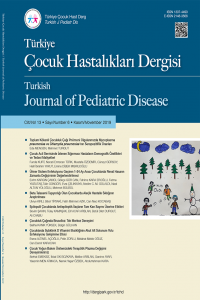Abstract
Down Sendromlu (DS; trizomi 21) infantlar, yenidoğan döneminde Transient Anormal Miyelopoez (TAM) olarak da bilinen, geçici myeloproliferatif hastalık gelişimi açısından risk altındadır. Transient Anormal Miyelopoez, DS klasik belirteçlerine sahip olan hastalarda görülebildiği gibi, Down Sendromu klasik belirteçlerine sahip olmayan mozaisizm gösteren hastalarda da ortaya çıkabilir. DS’lu yenidoğanların %4- 10’unda TAM gelişmektedir. TAM’lı bebeklerin çoğu remisyona girer ve herhangi bir tedavi gerekmez. Bu sunumda, kusma ve kanlı dışkılama şikayeti ile başvuran ve ileri değerlendirmeler sonucu; Mozaik Down Sendromu ve TAM tanıları konan yenidoğan olgusuna dikkat çekmek amaçlanmıştır.
Keywords
References
- 1-Massey GV. Transient leukemia in newborns with Down syndrome. Pediatr Blood Cancer 2005; 44:29–32.
- 2-Klusmann JH, Godinho FJ, Heitmann K, Maroz A, Koch ML, Reinhardt D, et al. Developmental stage specific interplay of GATA1 and IGF signaling in fetal megakaryopoiesis and leukemogenesis. Genes Dev 2010;24:1659-72.
- 3-Massey GV, Zipursky A, Chang MN, Doyle JJ, Nasim S, Taub JW, et al. A prospective study of the natural history of transient leukemia (TL) in neonates with Down syndrome (DS): Children’s Oncology Group (COG) study POG-9481. Blood 2006; 107: 4606–13.
- 4-Roberts I, Alford K, Hall G, Juban G, Richmond H, Norton A, et al. GATA1-mutant clones are frequent and often unsuspected in babies with Down syndrome: identification of a population at risk of leukemia. Blood 2013; 122: 3908–17.
Abstract
Infants with Down Syndrome (DS; trisomy 18) are under the risk for development of Transient Abnormal Myelopoiesis (TAM) during newborn period. TAM is mostly seen in classical form of DS but also might be seen in infants with mosaic type of DS. 4-10 % of infants with DS develop TAM. Most of infants with TAM, do not need any treatment and go into remission. Here, we tried to arouse interest on a newborn who has been consulted with compaints of vomiting and bloody stool and diagnosed as DownSyndrome with TAM.
Keywords
References
- 1-Massey GV. Transient leukemia in newborns with Down syndrome. Pediatr Blood Cancer 2005; 44:29–32.
- 2-Klusmann JH, Godinho FJ, Heitmann K, Maroz A, Koch ML, Reinhardt D, et al. Developmental stage specific interplay of GATA1 and IGF signaling in fetal megakaryopoiesis and leukemogenesis. Genes Dev 2010;24:1659-72.
- 3-Massey GV, Zipursky A, Chang MN, Doyle JJ, Nasim S, Taub JW, et al. A prospective study of the natural history of transient leukemia (TL) in neonates with Down syndrome (DS): Children’s Oncology Group (COG) study POG-9481. Blood 2006; 107: 4606–13.
- 4-Roberts I, Alford K, Hall G, Juban G, Richmond H, Norton A, et al. GATA1-mutant clones are frequent and often unsuspected in babies with Down syndrome: identification of a population at risk of leukemia. Blood 2013; 122: 3908–17.
Details
| Primary Language | Turkish |
|---|---|
| Subjects | Internal Diseases |
| Journal Section | CASE REPORTS |
| Authors | |
| Publication Date | December 23, 2019 |
| Submission Date | November 26, 2018 |
| Published in Issue | Year 2019 Volume: 13 Issue: 6 |
Cite
The publication language of Turkish Journal of Pediatric Disease is English.
Manuscripts submitted to the Turkish Journal of Pediatric Disease will go through a double-blind peer-review process. Each submission will be reviewed by at least two external, independent peer reviewers who are experts in the field, in order to ensure an unbiased evaluation process. The editorial board will invite an external and independent editor to manage the evaluation processes of manuscripts submitted by editors or by the editorial board members of the journal. The Editor in Chief is the final authority in the decision-making process for all submissions. Articles accepted for publication in the Turkish Journal of Pediatrics are put in the order of publication taking into account the acceptance dates. If the articles sent to the reviewers for evaluation are assessed as a senior for publication by the reviewers, the section editor and the editor considering all aspects (originality, high scientific quality and citation potential), it receives publication priority in addition to the articles assigned for the next issue.
The aim of the Turkish Journal of Pediatrics is to publish high-quality original research articles that will contribute to the international literature in the field of general pediatric health and diseases and its sub-branches. It also publishes editorial opinions, letters to the editor, reviews, case reports, book reviews, comments on previously published articles, meeting and conference proceedings, announcements, and biography. In addition to the field of child health and diseases, the journal also includes articles prepared in fields such as surgery, dentistry, public health, nutrition and dietetics, social services, human genetics, basic sciences, psychology, psychiatry, educational sciences, sociology and nursing, provided that they are related to this field. can be published.


